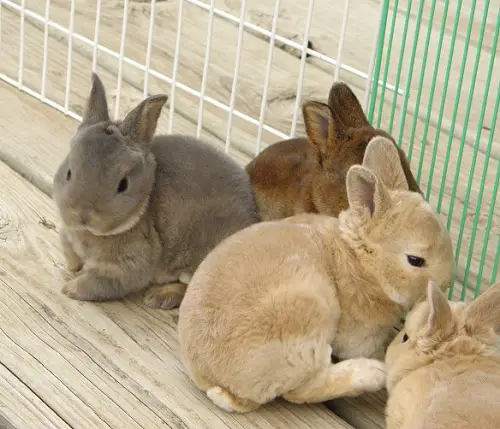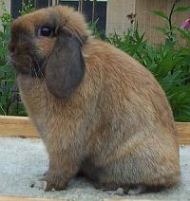By Laurie Stroupe
I love J-feeders. With the exception of my emergency overflow cages, all of my rabbits eat from J-feeders. Here are some things I’ve learned about them.
Lids
If you have hanging cages all on one level, lids are not only a waste of money, but they really slow down feeding. Just think about how much time it takes to open and close 60-70 lids, not to mention shifting back and forth between feeding and opening/closing. If you have stacking cages, you can eliminate the lids on the top feeders. Lids do protect lower cages from feed contamination by urine and feces. . [Editor’s note: small kits can sometimes climb up inside the feeders. Lids will help keep adventurous kits from  escaping.]
escaping.]
Capacity
I’ve heard people say they don’t like J-feeders because they hold more feed than they need. You don’t have to fill it! I just put as much feed as I need in the feeder. Even though it is not filled up, it serves an important purpose. I don’t have to open and close 60-70 cages. I take a quick peek to make sure they’ve eaten their last meal (I discard old feed) and then drop the new feed in. It takes just a few seconds per cage.
Caution: it is not a good idea to put several days’ worth of feed in a J-feeder. First, most rabbits should not be free-fed. Second, mold can develop. Third, rabbits may not eat stale feed. Fourth, rabbits may run out of feed before you anticipate and go from feast to famine (which can really upset their systems). And fifth, you need to check on your rabbits and their feed consumption daily anyway.
Litters
When you are feeding litters, you really appreciate the capacity of a J-feeder. I purchased some smaller ones when I first got started in Holland lops. They don’t hold enough feed for a large litter. So I move the smaller ones to bucks and dry does. I only wish I had gotten all large ones in the beginning. It would have eliminated a lot of feeder-moving now.
Deep Feeders
Sometimes called “wide mouth,” deep feeders are the only ones you should use with Holland lops, indeed any lop breed. Their large heads prevent them from eating normally from narrow ones. I saw a Holland DQ’d at a show for having strange wearing of the teeth. Both top and bottom teeth were wearing at a slant. The judge noted that it was probably caused by feeding from a narrow J-feeder. When the owner collected the rabbit, he confirmed that was the case. When large-headed breeds try to eat from narrow feeders, they turn their heads and chew unevenly, causing the slanted teeth.
Type
Don’t even bother with solid J-feeders. They can clog up with fines and hide moldy feed too easily. I don’t like the perforated bottoms either. I have some that I got when I first built my cages. From time to time, one of my rabbits will get a nail caught in them. I fear that one day I will lose a nice show bunny to a missing nail DQ. I’d like to get those replaced as soon as I am able.
I like the types with the screen on the bottom and back (e.g., Fine-X). The ones with screen only on the bottom would be my second choice. They keep the fines sifted out, which I think it important to your rabbits’ respiratory health (I use Blue Seal Show Hutch Deluxe, which has a lot of fines). I’ve never seen one of my rabbits get a nail stuck in the mesh.
Side Benefits
Besides being my favorite type of feeder, J-feeders also give me another metal surface, aside from my card holders, that I can use to place my magnet signs. I use these magnets to keep track of important information in the barn, such as when a doe is due.
I’ve saved the best benefit for last. There is nothing more adorable than seeing a three-week-old kit sitting on top of a J-feeder eating to its heart’s content! Too cute.

